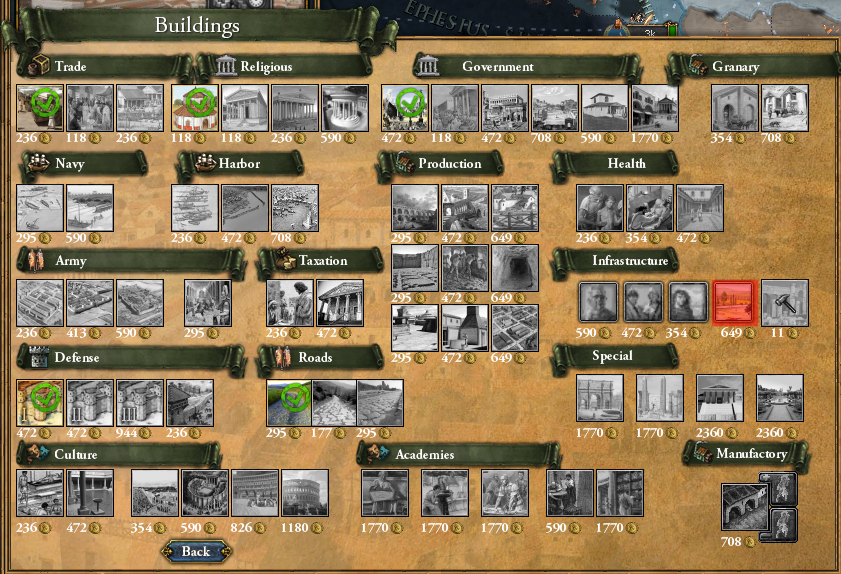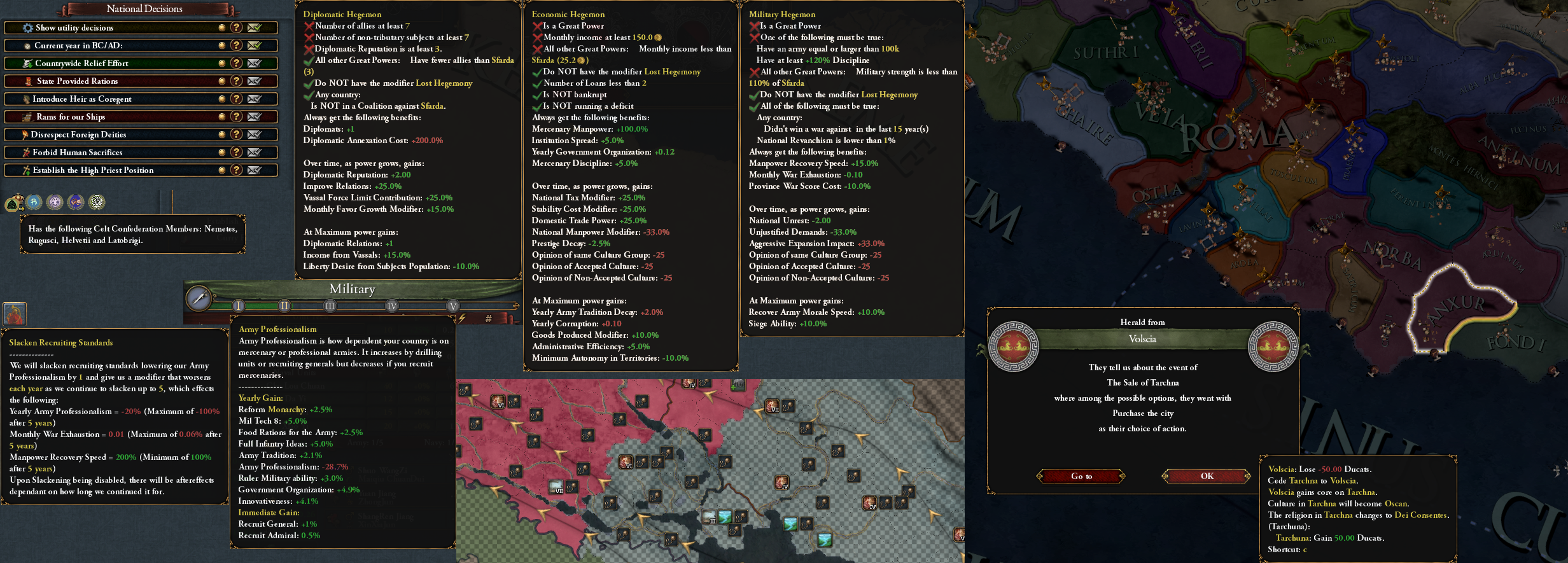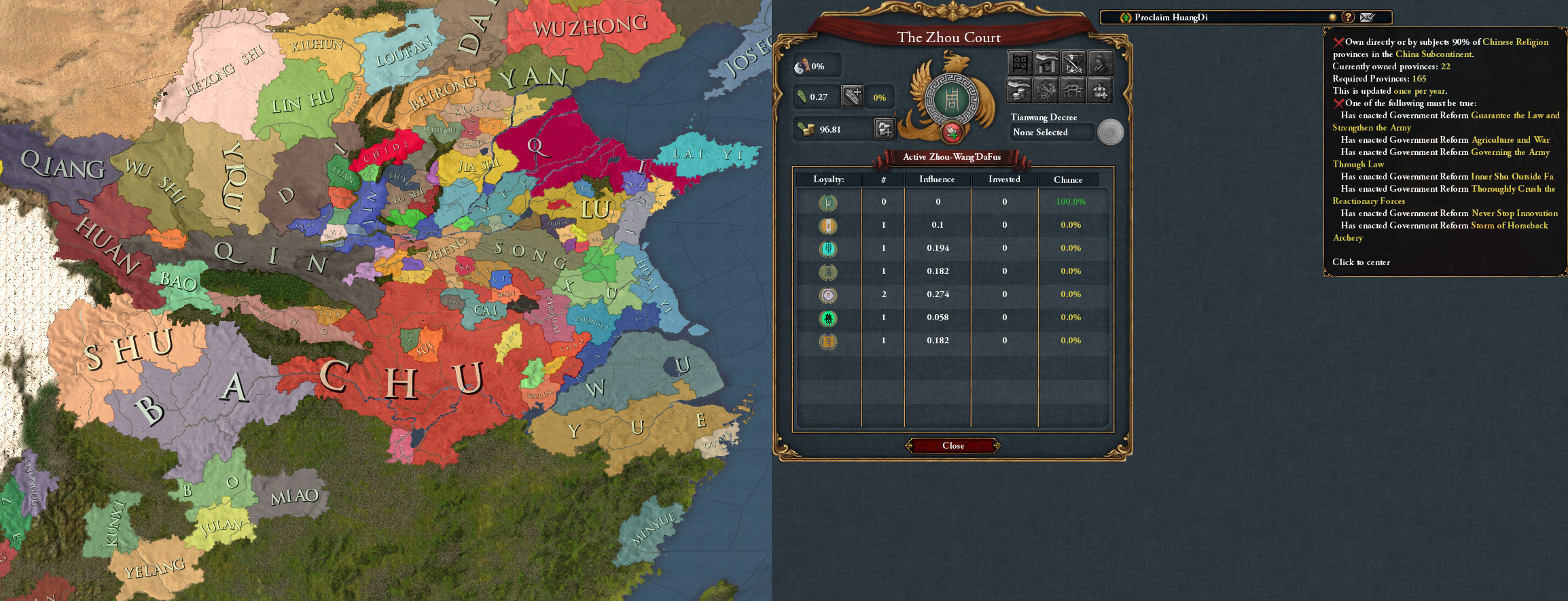Welcome back to another Mod Spotlight! Unfortunately this one was far too gargantuan to fit into a single steam post. (We tried). So the full version including a map and mission tree overview can be found over on our
main Forum post[forum.paradoxplaza.com] We'd encourage you to check it out if you want to hear more about the specific starts IU has to offer. Otherwise, enjoy the rest of the post!
--------------------
Imperium Universalis is a mod a lot of the EU4 community likely has heard of or seen at least once, but despite all the years and major rewrites of the mod, we are still around and being worked on!
But for those that
don’t know about Imperium Universalis, it is a mod attempting to depict Europe, North Africa, and most of Asia from 612 BC up until about 200 CE, encompassing the Achaemenids, Macedon, Mauryan Empire, and even the first Chinese dynasties. To do this, the mod is very, very different from vanilla in many key ways, although certainly not the most.
Before getting to those key differences, overviewing the map itself is more important.
The world, 612 BC

In 612 BC, the world is incredibly divided, with regions that saw previous stability falling into chaos as civil wars, upstart nations, and new religions come to dominate them. The Assyrian Empire is facing a losing war against the upstart Babylon, having lost Nineveh the day the mod begins. In Anatolia, Scythians and native Anatolians are vying for dominance as the Median empire looks on, and in the east, China is in the middle of the Spring and Autumn period - the old Zhou dynasty has mostly collapsed, but various Hegemons vie for power, claiming to protect what's left of the Zhou. However, if the region becomes consolidated enough, the Warring States period will begin, ushering in a new era of chaos...

IU features a long list of dates to play from, although some do not have as much content as we’d like. Generally, the earlier the startdate, the more content and balance there will be. I will explain notable startdates and the specific content they are meant to display further within the spoiler. If you want a start without waiting for many buildings or other milestones to unlock via tech - you should probably start in 474 or 490!
It’s time to get into more
specifically how the mod plays out, in-game.

IU features a custom pop system, with 3 classes of population: Upper Class, Commoners, and Tribal/Rural pops. Upper Class grants more wealth and goods, Commoners provide decent wealth and goods but also manpower, and Tribal/rurals grant more manpower but less wealth.
These pops will grow naturally over time to their respective Cap, determined by Buildings, Terrain, Center of Trade, Monuments, and various other modifiers.

In addition to changing Development, IU naturally also changes the buildings from vanilla, featuring many more buildings, in many more categories. These buildings range from regular tax-collecting buildings, to bathhouses, and to apothecaries, and everything inbetween. Alongside these, we also feature unique buildings, granting powerful bonuses to those rich enough to build them.

We have many more Institutions to fit with our extended playtime as well, progressing from Writing, Coinage, and Siegecraft, all the way to Blast Furnaces, Advanced Irrigation, and Engineering. These Institutions have a wide range of effects, and their spread is more, well, spread out, in areas well developed enough to receive them. There’s no silk road yet to transport knowledge, so you’ll have to invent it in your own area over time.

IU contains 8 ages throughout its timeline, and these ages contain MANY more abilities than vanilla, to account for the various polities and empires that may exist at any given age. The first few ages last about 80-90 years, but they begin lasting longer as the ages pass. The expanded GUI here is thanks to the creator of the Ages Reformed mod, MDoulos. (You can check out his
spotlight on Ages Reformed here[forum.paradoxplaza.com])

The entire world has been reshaped religiously, with there not being any huge blobs of “Animist” or some other generic Pagan religion. Each region has at least one, or multiple, religions to represent local customs and beliefs, many of which having some mechanic. These mechanics are typically cults, or other deity worship.

Government types have seen some reformatting, with Theocracies being reused to represent Oligarchies instead. Playing as tribals will typically take a lot longer to reform out of tribalism than in vanilla, but tribals also receive strong bonuses if they find themselves in a war with a more organized nation. Republics, and Monarchies are generally as in vanilla, but all gov types have seen reforms fully overhauled.

Government reforms have been fully changed from vanilla, with there being 14 Republic tiers, 14 Oligarchic tiers, 15 Monarchy tiers, and 11 Tribal tiers. Some tier reforms are shared between government types, but there are always specific tiers that add government specific bonuses. Republics and Oligarchies, of course, can adjust their term limits, along with all being able to choose from various bonuses. Tribals, get the choice to reform into the 3 other gov types, or stay tribal if they wish.
Economy The Economy in IU is much more tuned than most other mods, with modifiers and mechanics in place to both make certain playstyles somewhat more lucrative, and nerf those same playstyles if they become excessive.

One of these more lucrative mechanics, is that when you Annex a nation, either through war, or through diplomacy, you attain their Treasury. This means annexing a few OPM’s can net you enough cash to fund a few Manufacturies in your homeland. This however, has a downside. Done excessively, or without checking, your Inflation can begin to skyrocket if not checked.
As seen in the above image, Inflation will increase on its own without anything holding it down, and if you go beyond 4%, even Economy Ideas won’t bring it back down to 0%. Paying it down with ADM Mana, is also increased in cost, making Inflation a threat to your expansion if you take too much in wars.
There are some decisions to counteract Inflation from ruining your run, as well as bankruptcy heavily decreasing it, so it is recoverable. These will come at their own costs, though, but not taming Inflation will be much worse.

As with any mod or game representing this era of history, slavery, in many forms, was abundant. From state-owned slaves, to pseudo-serfdom, there were many variants of this. To try and represent the vast possibilities and gradients, we have a slaves estate, which holds the laws governing the rest of the mechanics for slavery. Beware though, having too many, will lead to intense unrest and other negatives.

The population of Slaves will increase or decrease over time depending on the laws set in the Estate, and the amount Liberated will join your regular Population in your provinces over time. Slaves can either exist ambiguously and add to your global Slave Production, contributing to global Goods Produced %, or be placed in Provinces with an appropriate Manufactury, or a Production building, directly increasing goods there.
Placing Slaves can be incredibly lucrative in provinces with Urban Population, and a valuable Trade Good, for example. It may be worth your Slaves for these provinces and letting others contribute to the global modifier, but that’s up to the player. You can, of course, distribute them in all your Provinces, but you will get a much lower global Goods Produced modifier.
The amount of slots per province will be increased by the production building (1 per level) and the manufactory, if your Slave Estate laws allow for that type to be used.

Admin stress is the main driver behind this balancing, and it works through a modifier that begins applying at 400 development, and increases every ~400 development after, for 12 levels. The modifier lowers income modifiers, while increasing corruption, which the player is meant to pay off with cash, further limiting their treasury.
With Admin Stress, the player will find their treasury empty if they mismanage their economy, expand before they’re in a good situation, or take too much non-valuable land for themselves. It is manageable if you pace your expansion as tech and your country develop, but rushing expansion before your economy is ready will cripple you, and perhaps lead to a collapse, or at least shrinkage
Other Nation-specific content not mentioned available to view on the forums[forum.paradoxplaza.com] But, that’s just stuff that exists in the 3.1.2 version. We have been hard at work, and although we are not close to a release, there are many things that have been added or improved upon.
Future content preview [expand type=details ]

There’s a lot of changes too small to be given their own section, but too impactful to go un-noted. So, I’ll list some of those here:
Decisions, have all been given icons and colours to help make it easier to identify which are which and of those, what ones may be useful to you.
Hegemonies have been reworked to fit the theme better, being easier to achieve, leading to countries that were Hegemons attaining them more realistically.
Many flavour events have been added across the globe, an example being the Volscians getting an event to purchase a city from Tarquinia. 2 Provinces have also been added near Volscia. Can you spot them?
Army Professionalism has been entirely reworked, partly inspired by MEIOU, to work as an equilibrium. Balanced by many things - Idea groups, Government type, Government Organization, Decisions - it will go up & down over a game depending on actions and routes taken.
Along side this, the Slacken Recruitment button has been changed to impact the new system properly, and be slightly more impactful after disabling.
AI will now place slaves in its provinces, albeit they are not as smart as players with using them.

Socii have also seen another full overhaul, with the major annoyances with the old system flattened over. Dissatisfaction now works as a custom gov mechanic, allowing the player to see at a glance where they’re at. This also means that the modifier increases linearly instead of in steps, stopping sudden changes in liberty desire.
Along with Dissatisfaction being a bar, 3 new minor bars are present, representing Administrative, Diplomatic, and Military leverage over your Socii. Accompanying these are 3 buttons. Calling your Socii to wars will work as the normal button does but for all Socii at once, just a time-saver. The other 2 do new things. The 2nd, “Enforce Roman Rule”, will allow you to annex one Socii regardless of the current Socii Ratio. The 3rd, “Overenlist Socii Troops” gives an Estate Privilige to the Socii Estate that will lower reinforcement manpower costs for your army, alongside taking 10% of each Socii’s manpower.
The Socii Estate has many other privileges I won’t go over here, but many of them will require parliament issues to be passed. They buff either the Socii, Socii and your provinces, and some may penalize Rome slightly in favor of granting the Socii some privilege.
Some other notable Rome changes are:
The name of Rome will change more throughout the early parts of a game to reflect the current situation.
An event has been added early in the mission tree to colonize Circeii.
Some events are now present for Punic-Roman early relations.
Romanization is locked behind Parliament Issues.
Definitely more.

Anatolia now begins even more chaotic than previously, with central Anatolia now more divided. Upon Scytheni’s invasion of Cimirria, the Lydians will get an event to invade and subjugate Phrygia, alongside a powerful modifier for expansion, turning it into a buffer state between the two powers. At the conclusion of the Assyrian collapse, should Babylon win, Cilicia gains independence.
The Scytheni can then attempt an invasion of Cilicia, which they will likely fail in, or more likely; Media will invade the Scytheni and swallow the majority of them whole, leaving the northern coast to splinter into independent states.
Alongside Anatolian changes, the Caucasus has had a 2nd go-over and has been adjusted with different countries, cultures, and a new religion in the area.

There have been an immense amount of small QOL changes, or balancing changes, to China. I cannot cover all of these, but I can note the biggest ones. Such as, the eastern coastline, and all rivers in China, have been adjusted to be more accurate to sources depicting the era. Including redirecting and thinning the navigable rivers, more rivers have been added all across China, no longer having areas barren of rivers where there should be.
The Papacy mechanic has also been integrated properly into China, with new images, sprites, and some of its interactions being reworked to do different things.
Unifying China should be much less tedious also, as the decision’s requirements are no longer tied to owning every single Chinese religion province.
And last, but definitely not least, something that may come far, far in the future…

IU’s pop system is something the mod has kept for a very long time - and while this rework would not do away with having a pop system, it would see IU’s completely supplanted by something much better for performance, and that would allow us to represent many more things, with much better accuracy. With help and permission from the
Atlas Novum[discord.gg] team, we have adapted their pop system, and building array, to fit within IU.
In its current implementation, 1 pop represents 1,000 people, instead of the previous 1 to 10,000. This allows us to better represent the disparity between Rural and Urban provinces much better, as EU4 doesn’t much like having 1 dev provinces all over the place.
The other 2 dev types, no longer represent any population types. Upper class, tax, is now representing Wealth, a cumulative approximation of, well, the amount of wealth in a province.
Commoners, Production, is now Infrastructure, which will increase province ‘Civilization’; required for upgrading certain buildings, along with increasing Population and Wealth growth.
Along with allowing more granularity in population, this system removes the RNG that plagued the old population systems, and you can now see - and predict - exactly how much your population is growing in each province. Wealth, also grows autonomously, but you can manually invest in a province’s Wealth or Infrastructure.
I won’t go further indepth, as the implementation of this system is VERY, VERY early, and I’m not sure how much will change as it goes further into development, or even when that will properly take place. You will have plenty of the old pop system to enjoy, if you prefer that. It will still be optimized and taken care of until and if this system becomes polished enough to work, but accommodating both systems at the same time would sadly be impossible.
[/expand]
To end Imperium Universalis is a truly huge mod, and there are many things I wish I could’ve gone over in this spotlight, that I didn’t have time or room for. Perhaps there will be another, or we will make Dev Diaries for them, or something similar. Of course, we always post frequent teasers on the
IU Discord[discord.gg], and you can get the mod just about anywhere.
3.1.2 Steam Workshop (Main Page)Development Build Steam WorkshopParadox Mods Development Build[mods.paradoxplaza.com]https://steamcommunity.com/sharedfiles/filedetails/?id=679204773

















